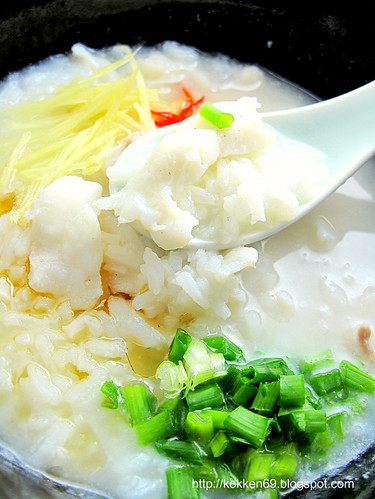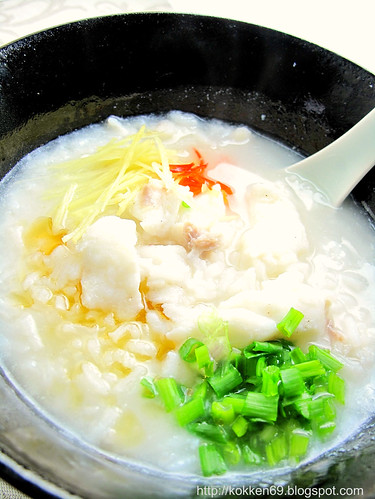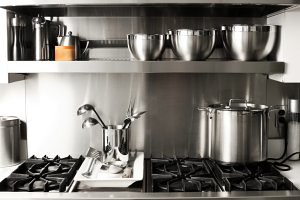

When L and I were in Penang last month, we ate all our meals at street side food stalls. For one of the dinners, L ordered some pig intestine porridge which I had frowned upon. It was suprisingly delicious. L said something which stuck in my mind - the Teochew style porridge was cooked so well that even though it is cooked soft through the core, the grains had remained intact. This is rather different from Cantonese congee where the rice is cooked in water that is kept at a rolling boil. The rice grain tend to split after a few minutes of vigourous boiling and the end result is a smooth, gluey - almost paste like consistency. I do enjoy the Cantonese congee (especially with chinese fried croutons Youtiao) but the Teochew porridge offers a different experience in texture that is equally satisfying - if it is cooked right.
When it is not done right, Teochew porridge can taste like rice mixed with soup. Perhaps it is for this reason that I don't normally order Teochew porridge when I eat out. I have been pondering about how to achieve 'mushy soft' rice grains without splitting the grain. Obviously, the heat needs to be controlled carefully but I also can't help but feel that there may be other tricks to it. I recall someone telling me how using 'soft water' to boil red bean soup yields soft bean without turning the soup into a mushy gruel.
Armed with that little piece of hear-say, I decided to experiment. Hard water, by definition contains calcium and tends to be alkaline in nature. In nature, water can be softened when it is passes through peat, sandstone or some sedimentory rocks. I remember I have a set of chinese tea cups that are made from clay. I immersed one of my cups in a pot of water overnight and used this water to cook my porridge. For most part of the cooking process, the water was maintained at a reasonble rolling boil and at the end of the cooking process, I was delighted to observe the rice grain did not split and it was cooked to the core.
I need to verify again if this is indeed due to the water but then, deep down, I am also scoffing at myself. Who am I kidding? Will the food stalls really go through the trouble to treat their water before cooking?
Anyway, my fish porridge was really tasty. Apart from the soft whole rice grains, the sliced fish turned out really smooth and firm. It was wholesome and satisfying and I am pretty confident that L will be impressed.
Recipe :
White Jasmine Rice (thai long grain rice) : 1 cup
Water : 10 cups (actually I never really measure the amount of water used when I cook porridge.It is less critical than cooking rice)
Sliced fish fillet , marinated with a little salt, chinese wine, egg white and corn starch.
For garnish : finely juliened ginger, finely sliced chilli, chopped spring onion.
( Unlike baking, I never get precise when I do Chinese cooking. The best measuring device is your tongue.)
Method :
1. Bring water to boil in the pot.
2. Wash rice until water is clear. Add a little oil to the washed rice. When the water starts to boil in the pot, add the washed rice into the pot. Use a ladle to stir the rice grain quickly to prevent them from settling down.
3. Adjust heat to get water to a gentle rolling boil. (not simmer) I left the lid of the pot slightly ajar.
4. Check at intervals to see if rice is cooked. Add hot water if water level in the pot becomes too low. (again judge by your own preference how 'soupy'you like your porridge to be)
5. When rice is almost cooked through, add marinated sliced fish. These should cook through pretty fast. Season with salt to taste.
6. Ladle the porridge into a bowl and garnish with ginger, spring onion and chilli. I also added a little seseame oil to my porridge.









12 comments:
Your porridge looks lovely and delicious! Yum!
It sounds so interesting. I will try if I have a chance. I love Teochew porridge and I know what you mean by stalls mixing cooked rice with water to make that bowl of Teochew porridge...bleh :O
Nice pic! I would have added chicken broth rather than water though since you're going to drink that soupy liquid. What do you think? That's just what my mum does at home and no, I'm no Teochew!
Allie, Tigerfish - Thanks for stopping by. Like I said, I still need to verify if my theory is correct.. will keep you posted :)
Quinn - Yes, indeed. Adding chicken broth would definitely enhance the flavour. I did not have any chicken broth on hand so I just seasoned it with salt - which tasted suprisingly good too...:)
From what I know.. most people will cook the porridge until the rice is just cooked and turn off the fire. Let the porridge sit until the rice grains expand.
Putting in a porcelain spoon into the porridge while cooking will save u all the trouble of stirring.
This is something I learnt from my late grand aunt.
Yummy! I love porridge like that. If you want to use less water, just soak the rice grains for at least 30mins. I used to soak them overnight so that I could make porridge for my kids first thing in the morning. It will also cook very quickly because the soaking would have softened the grains. I like to cook porridge using a claypot. Sometimes, I add a lil salt and a couple drops of oil during the soaking to make it even smoother :)
Wendy, Thanks for the tips. I tried cooking it the second time round with normal water in my new cast iron pot and did exactly what you suggested. I turn off the fire and let the porridge sit. The cast iron really keeps the heat in really well... :)
Ju, great tip! Makes sense - that's what I was told to do when I wanted to steam glutinous rice or cook sago... Will try again when I get back from my business trip...no more cooking for another 2 weeks!
So happy to get all the great advice. Thanks, Ladies!
I am trying this when I get a chinese clay cup. :)
Hi Zurin, don't bother about the Chinese clay cup LOL! I have not verified whether the theory works! Thanks for dropping by!
Once I saw on a Chinese eating show, interviewing a famous Guangzhou porridge shop, asking the techniques of making smooth porridge. The owner said, The rice is marinated with salt and oil and they used to cook porridge with well water, and it's really smooth. Now that they no longer can use well water, they subtitute with some century egg yolk mixed in to marinate the rice before cooking.
Century egg yolk is alkaline :) So is well water :)
Hi Wendy,you know, now that you've mentioned it, I do remember reading something about using century egg yolk. That would be the cantonese porridge,I guess. I am going to try it out and let you know.
Yup, yup, Cantonese porridge. Cos the restaurant I mentioned made some real smooth rice porridge.
Post a Comment